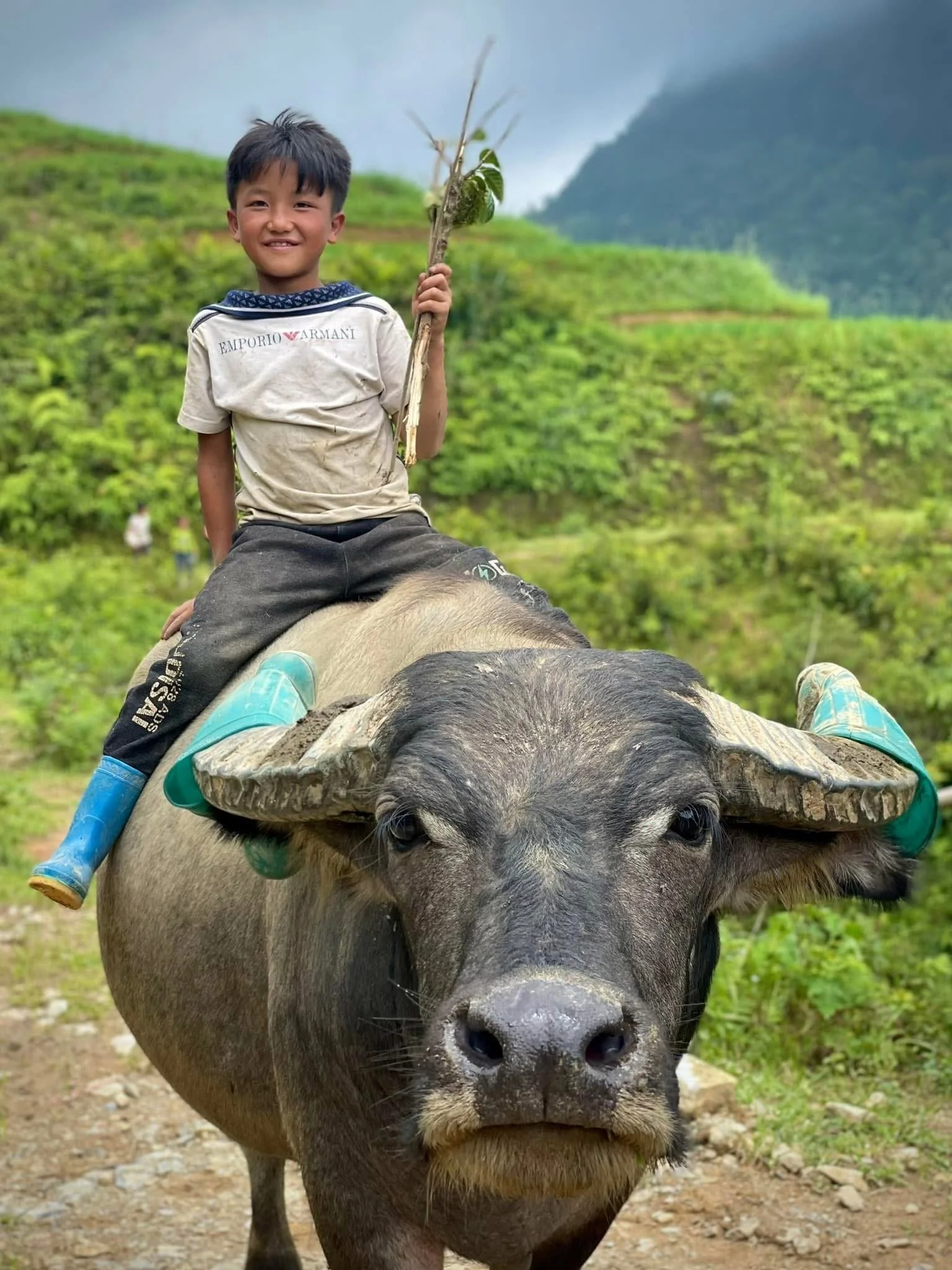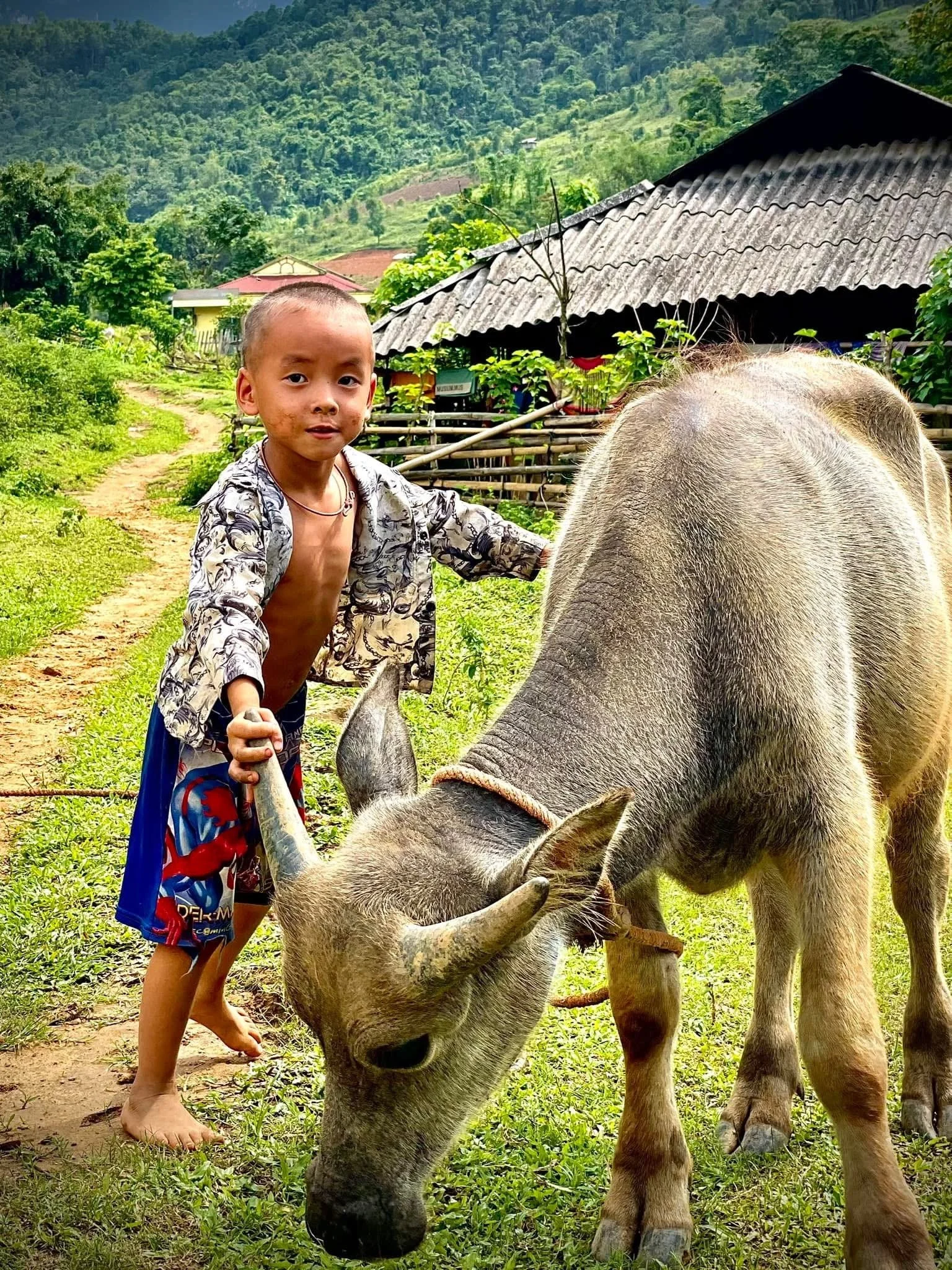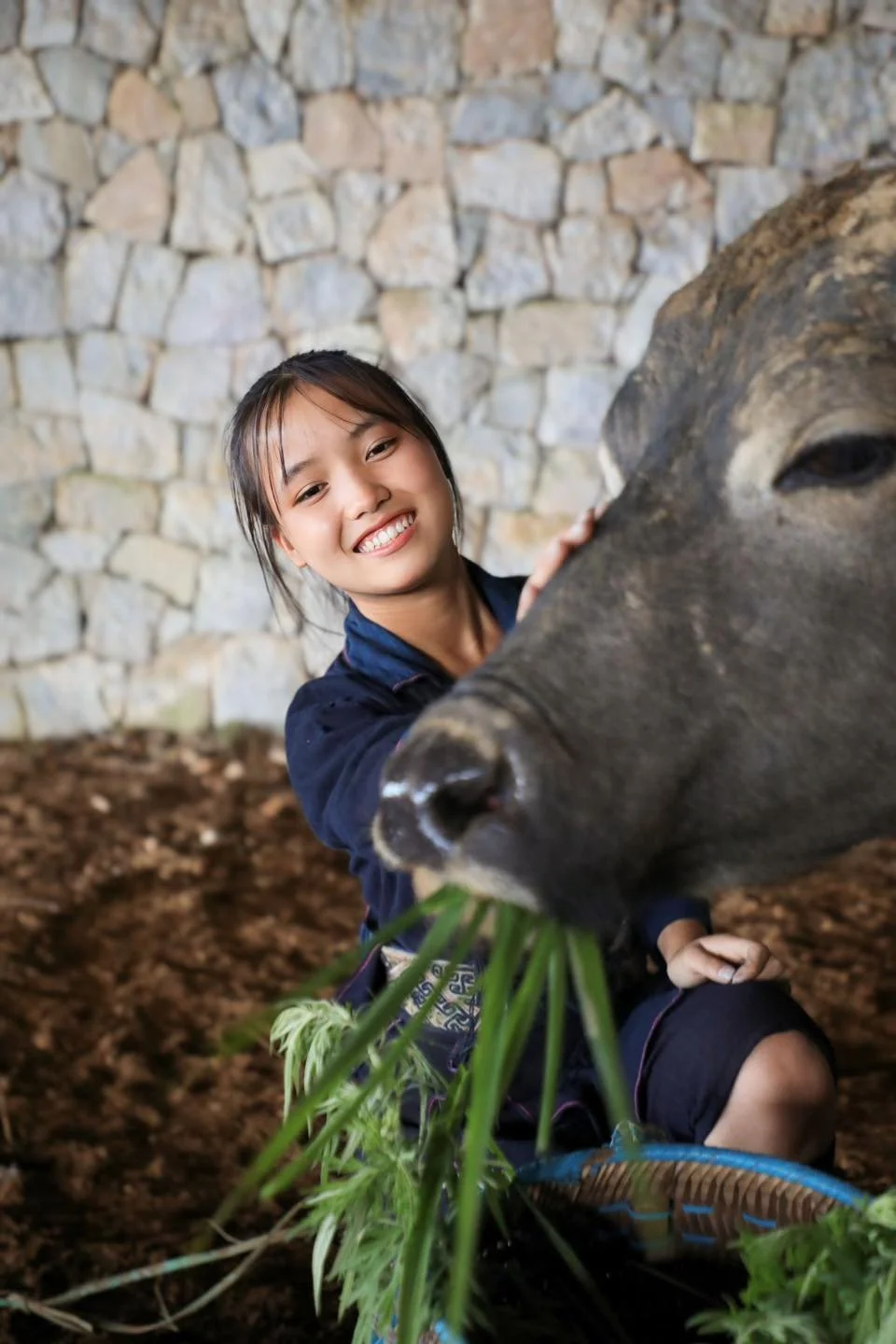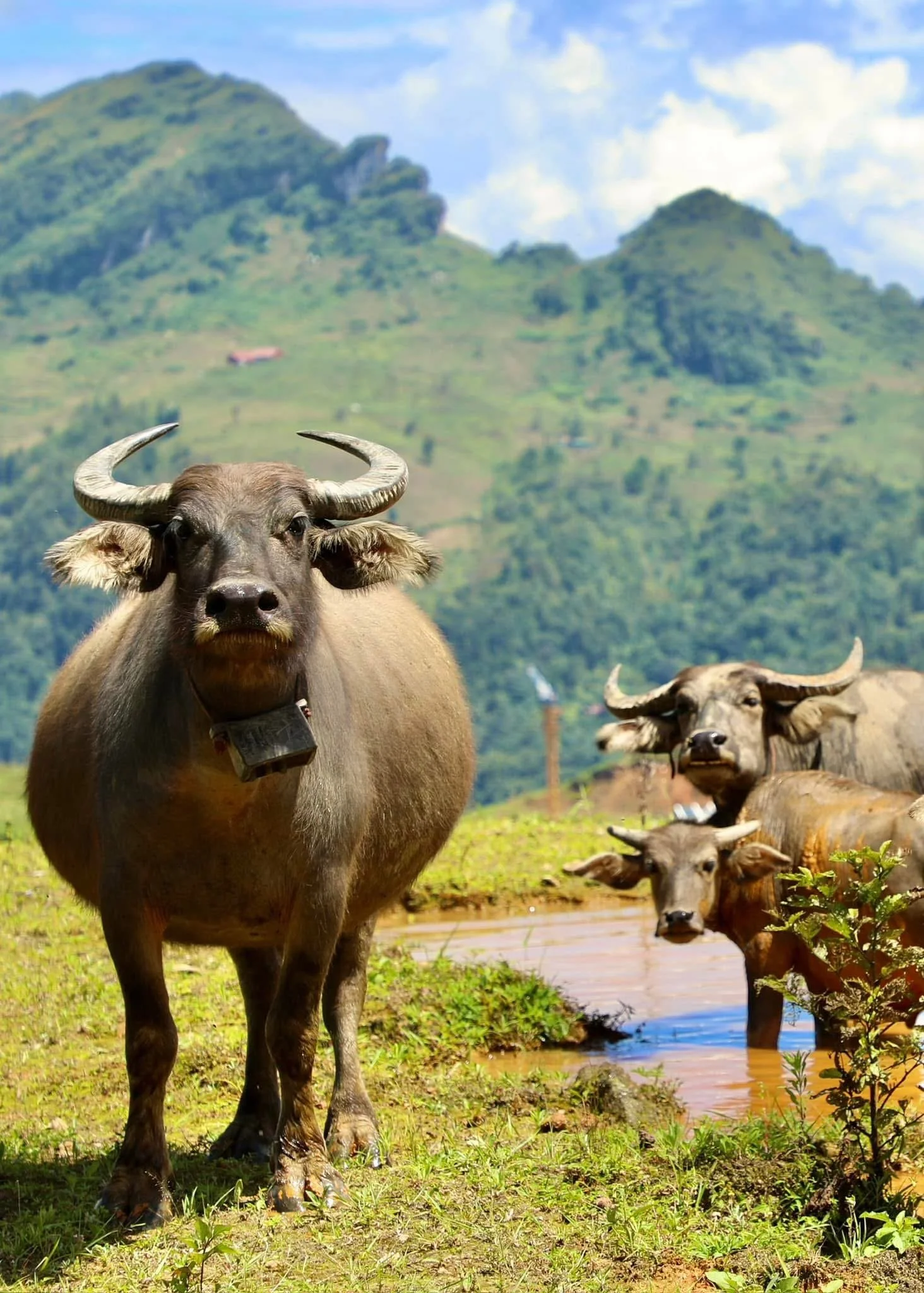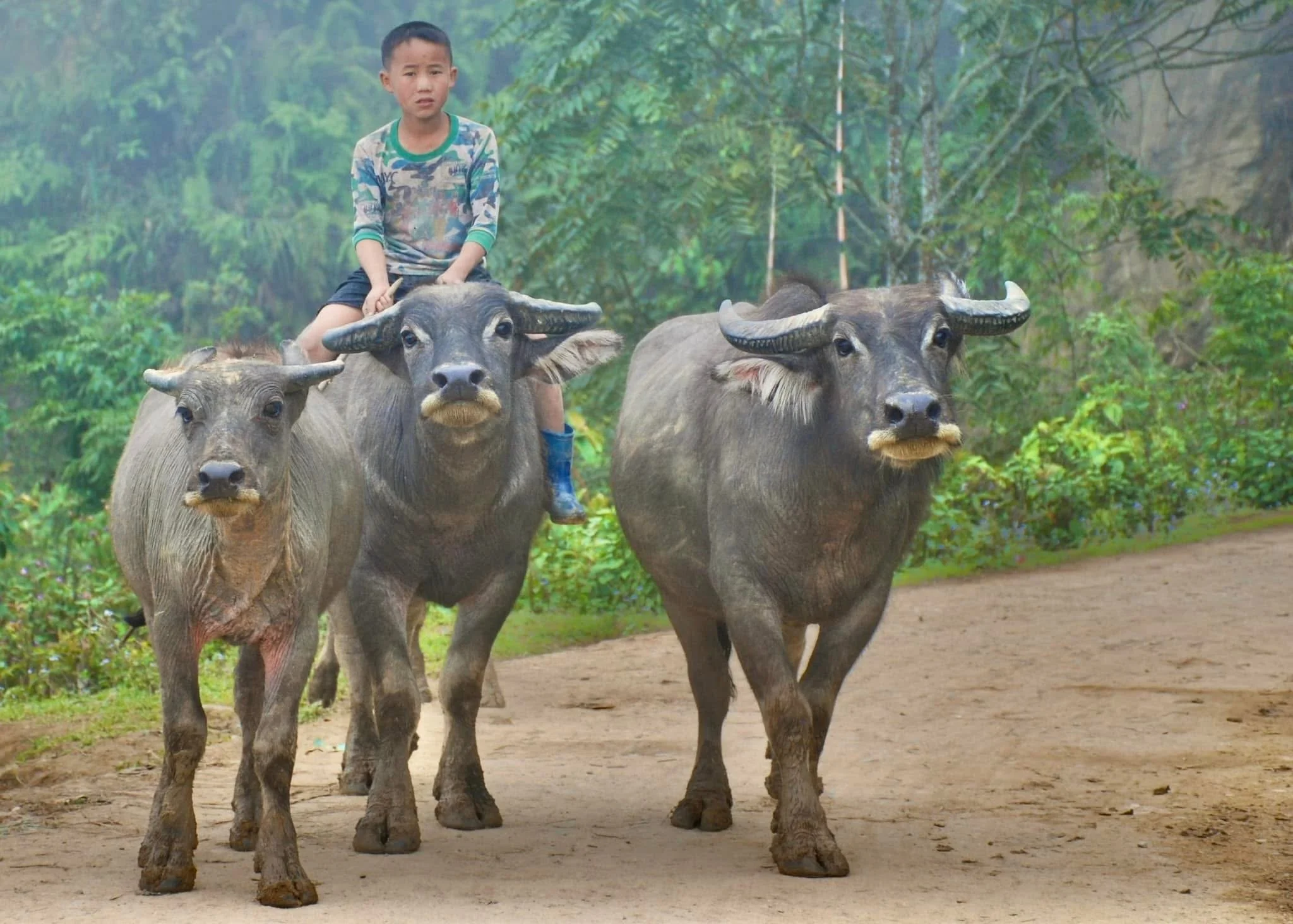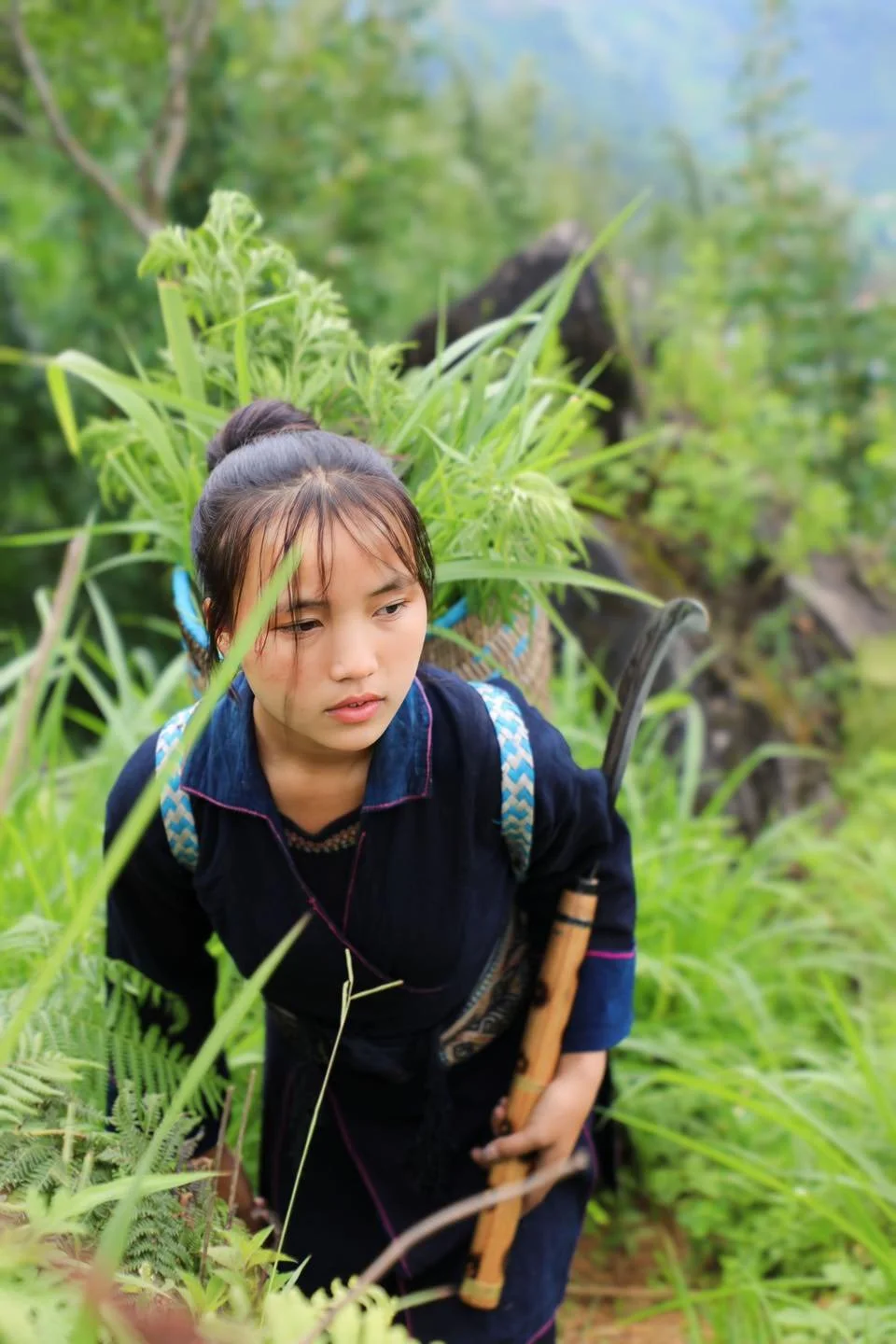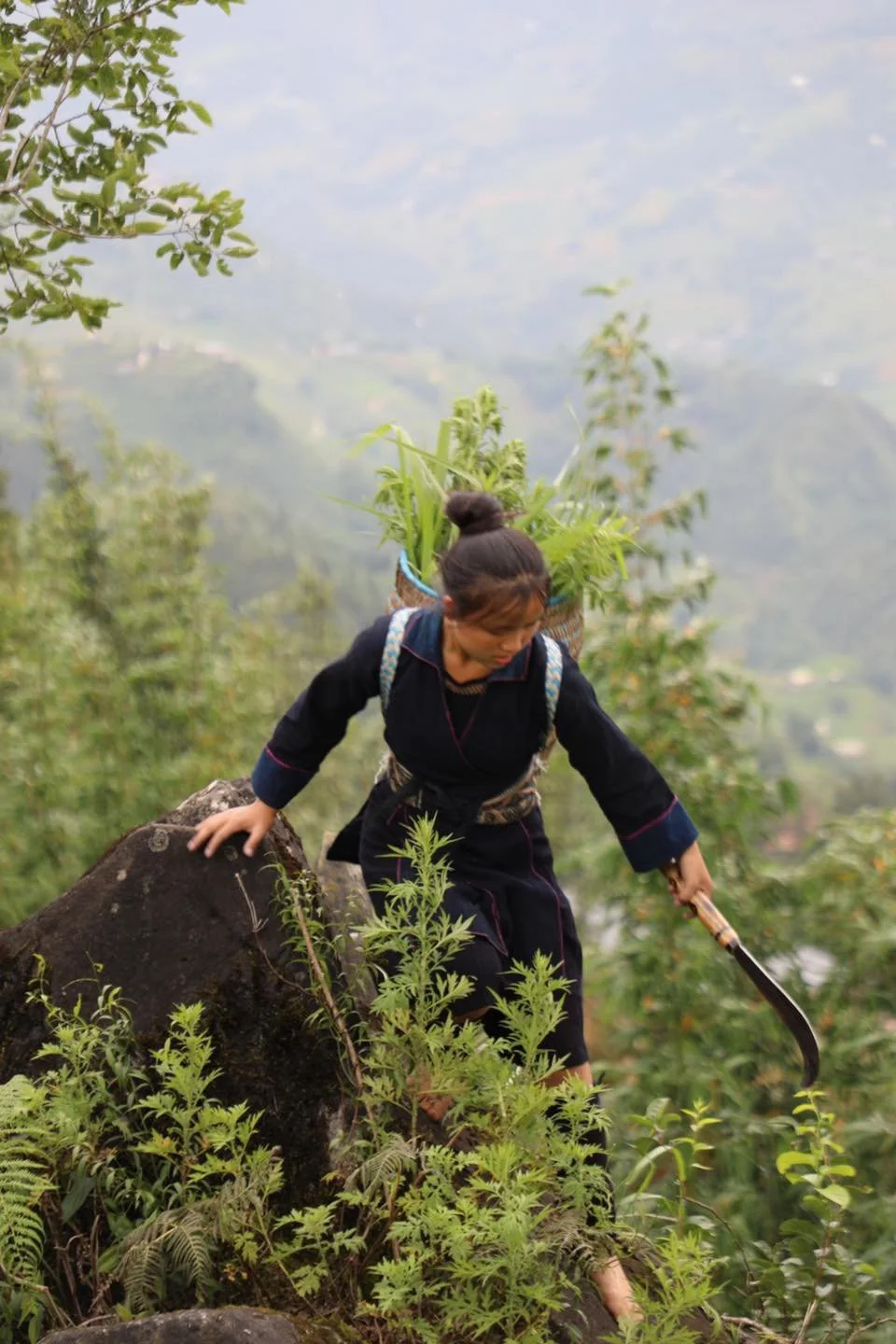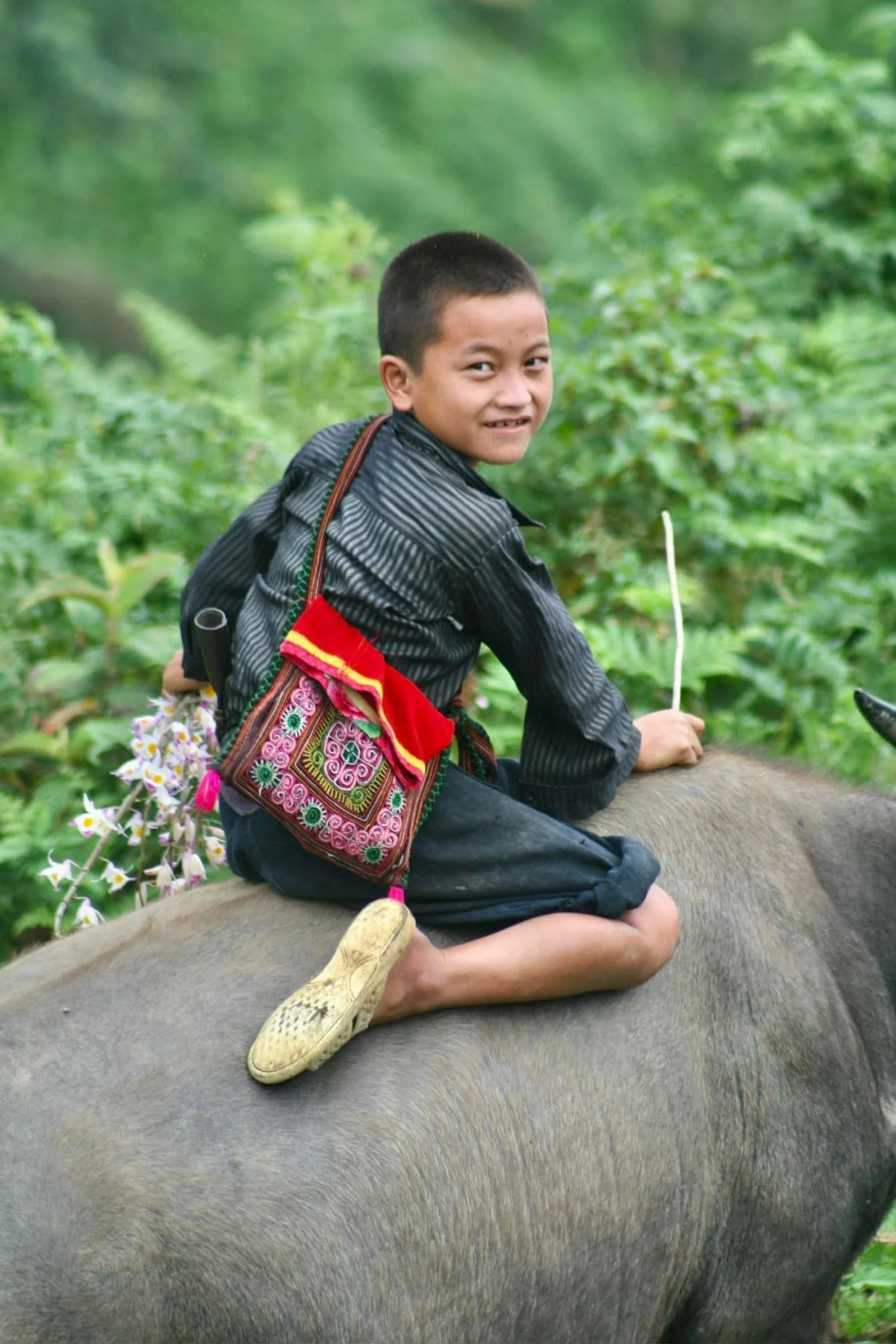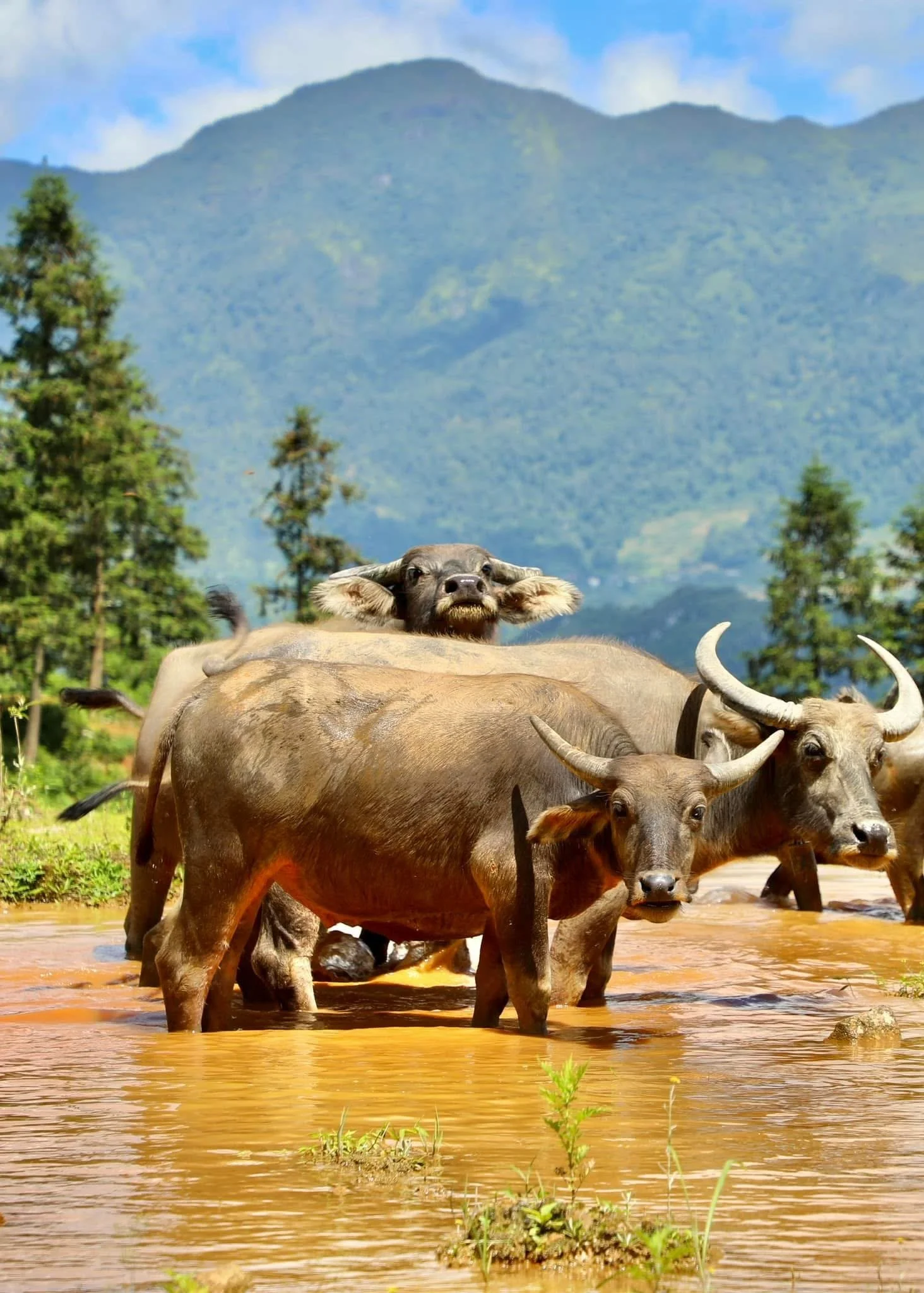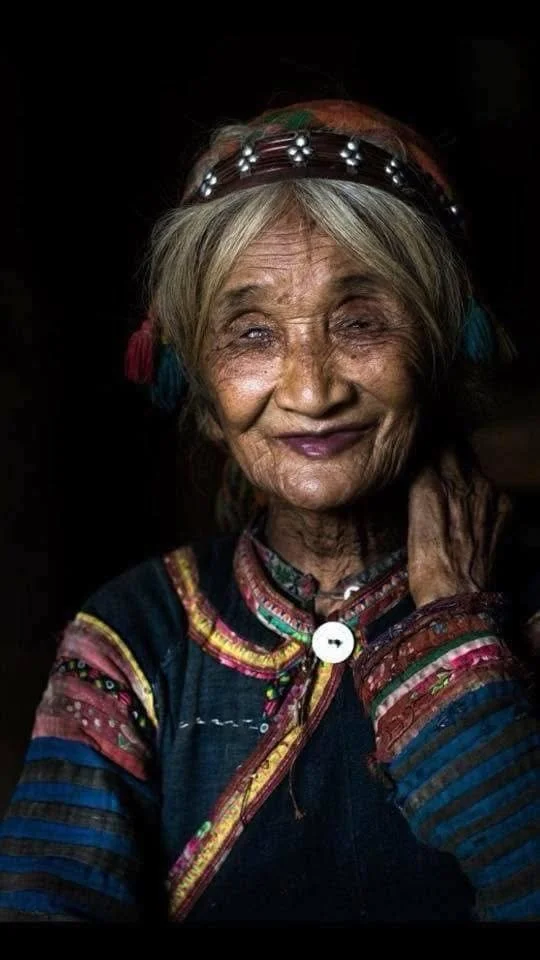Insights and Stories from Sapa and the Northern Borderbelt provinces of Vietnam.
The Heart of the Highlands: The Hmong and Their Water Buffalo
In the highlands of northern Vietnam, the Hmong share a close partnership with their water buffalo, animals that shape their fields, traditions and way of life.
Strength in the Fields
In the mist-covered highlands of northern Vietnam, water buffalo have long stood as steady companions to the Hmong people. They are not merely animals of burden; they are the pulse of rural life. Their strength and endurance make the cultivation of rice and corn possible on steep, uneven slopes where machinery cannot reach. When the plough cuts through the damp earth, it is guided not just by human hands but by a rhythm shared between farmer and buffalo, a quiet understanding built over generations.
For many Hmong families, the buffalo ensures survival. It provides the muscle for planting and the means to feed entire communities. In return, it receives careful attention, shade in the summer heat, clean water from mountain streams, and the steady hand of a child who guides it home at dusk.
A Living Symbol of Wealth and Honour
To own a water buffalo in Sapa is to hold both pride and security. Only about one in ten families in the district have the means to keep them, and for most, they are the most valuable possession they will ever own. Beyond their labour, buffalo represent wealth, stability, and prestige. Their presence at cultural rituals, particularly funerals, underscores their deep spiritual importance.
For the Hmong, the animal embodies prosperity and endurance. Its image appears in folk tales, songs, and embroidery patterns that tell stories of strength and loyalty. It stands as a quiet symbol of the patience required to live in harmony with the mountains.
Guardians of the Land
Between September and April, when the fields lie fallow, buffalo roam semi-wild across the forests and valleys of Sapa. As planting season approaches, they are brought back to graze under watchful eyes. Children often take on this role, herding the animals with laughter and care, ensuring they stay clear of the tender new shoots of rice and corn.
Families work together to protect them, repairing fences, building shelters, and collecting forage. It is a labour of respect, an act of reciprocity. The health of the buffalo is tied to the well-being of the family itself.
A Bond Beyond Work
It might sound strange to those who have never lived alongside them, but water buffalo are often treated as part of the family. They are spoken to softly, their moods understood, their habits anticipated. Farmers know the sound of their calls as well as their own children’s voices. When a buffalo falls ill, the worry is genuine, almost personal.
This bond is rooted in necessity, yes, but also in affection. Over time, work shared under sun and rain builds something deeper than utility. It becomes companionship, one that bridges the fragile line between human and animal.
The Spirit of the Mountains
In Hmong culture, the water buffalo stands as a reminder that strength is not loud or boastful; it is steady, enduring, and gentle when it needs to be. These animals carry the land’s memory in every step, shaping terraces, feeding families, and quietly weaving themselves into the rhythm of mountain life.
They are, in the truest sense, the heart of the highlands.
A Smile Across the Mountains
In the misted highlands of Vietnam, two La Hù sisters spent sixteen years apart, their reunion arriving not in person but through a single photograph. This is a story of memory, resilience and love that travelled further than any road.
The Sisters Who Waited for Time to Catch Up
Though separated by less than five miles of steep terrain, sisters Lý Ca Su and Lý Lỳ Chí had not seen one another for over sixteen years. Their final years unfolded in quiet solitude, filled with longing, memory, and the ache of distance. The eldest sister had long since passed away, lost to hunger during a time of great scarcity; a sorrow that lingered in every conversation that followed.
The sisters belonged to the La Hủ ethnic group, one of Vietnam’s smallest and most secluded communities, numbering fewer than ten thousand. For generations, the La Hủ lived as semi-nomadic hunters, following the forest’s rhythm across the misted highlands of the far northwest. Change came suddenly in 1996, when hydroelectric projects and government reforms encouraged the community to settle permanently. The forest paths gave way to villages and fields. The transition was uneasy, as traditions adapted and some, quietly, faded.
A Life Divided by Mountains
Lý Lỳ Chí left her childhood home at seventeen. She married early and settled in a neighbouring valley. For many years, the two sisters would make the long, arduous trek along a narrow mountain path to visit each other, their journeys a thread of connection between ridges. But time is unrelenting. Age weakened their steps, and the trail grew quiet. Sixteen years passed without reunion.
By ninety-three, Lý Ca Su had gone completely blind. Her younger sister, at one hundred and three, could still see, but her hearing had faded almost entirely. With no literacy, there were no letters. With no electricity, no phones. The silence between them stretched impossibly wide.
Progress Arrives Too Late
In 2019, a new road was completed linking their villages. What had once taken days could now be done in two hours. Yet for the sisters, it changed nothing. Neither could ride a motorcycle, and there were no cars or buses. Even electricity remained a rumour. The distance was only five miles, but it might as well have been a hundred.
And still, life has its small mercies.
The Photograph That Crossed Mountains
Two years earlier, photographer Réhahn had taken a portrait of Lý Ca Su. Her face, deeply lined, seemed to hold entire lifetimes. Her smile was gentle; the kind that hums quietly rather than shouts. When ETHOS visited the La Hủ villages, they carried that photograph with them and showed it to Lý Lỳ Chí.
For a brief, trembling moment, her eyes brightened. Recognition flickered. The years fell away. She saw her sister’s face again, if only in an image. Tears came, soft and sudden. There was reunion — not in person, but in spirit.
What Remains
Now both sisters have passed beyond this world, and that single photograph holds what words cannot. A connection unbroken by mountains or silence. A reminder that love, in its simplest form, can travel further than any road.
Sometimes, the distance between two hearts is measured not in miles, but in memory.
Thank you to Rehahn for the wonderful photo. To see this and many other portraits, please considering visiting the Precious Heritage Museum in Hoi An.
The Beautiful Mystery of Blonde Hair Among the Hmong
High in the mountains of Southeast Asia, some Hmong children are born with naturally light brown or blonde hair. Science has yet to fully explain this beautiful mystery.
A Rare Sight in the Mountains
The Hmong people live across the highlands of Vietnam, Laos, Thailand and southern China. Their culture is known for its vibrant textiles, farming traditions and deep connection to the mountains they call home. Dark hair is the most common trait within these communities, which makes it even more surprising when a child appears with naturally light brown or even blonde hair.
The photographs above show several Hmong children with strikingly fair hair. Their colouring often catches visitors off guard, as it stands out against the more familiar dark tones seen across the region.
What Causes the Lighter Hair?
The exact reason for lighter hair in some Hmong people is still unclear. Scientists believe it may be linked to unique genetic variations passed through certain family lines. Similar traits have been observed in other isolated communities around the world. However, there has not yet been enough research to determine the precise cause within the Hmong population.
What is certain is that these features occur naturally. The hair often darkens with age, yet in childhood it creates a captivating contrast that draws curiosity and admiration.
More Than Just a Genetic Puzzle
While genetics may offer one part of the answer, the real beauty lies in the way these children carry their heritage with pride. Whether in traditional embroidered clothing or simple school uniforms, their presence is a reminder that culture is not defined by appearance alone.
Each face tells a story of mountain life. Fields, forests and open skies shape their daily world far more than hair colour ever could.
A Living Reminder of Diversity
The Hmong community continues to surprise and inspire. Their traditions remain strong, even as science works to understand the rare traits found among them. Until more studies are done, the blonde hair seen in these villages will remain one of nature’s quiet wonders.


